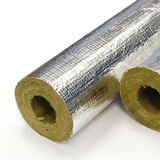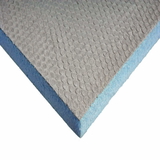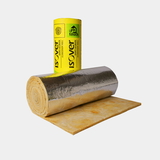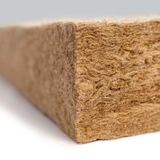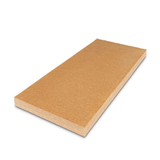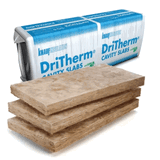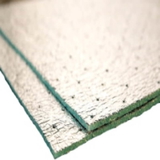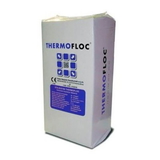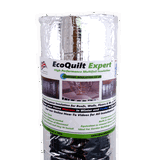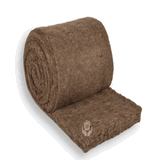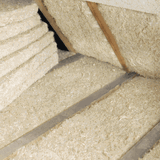- Blogs
- Difference Between U Value, R value, k value And Other Terms Used For Insulation
Difference Between U Value, R value, k value And Other Terms Used For Insulation

Insulation is a material or a combination of materials that reduces the amount of heat transfer between two environments. Insulation can help keep your home warm in winter and cool in summer, as well as reduce your energy bills and carbon footprint.
In this article, we will explain some of the common terms and metrics used to measure and compare insulation performance in the UK.
U-value
U-value is a measure of how much heat passes through a given area of a material or a structure. U value measures the thermal transmittance of materials as the rate of transfer of heat through matter.
The lower the U-value, the better the insulation. U-value is expressed in watts per square metre per degree Celsius (W/m²K). U value depends on the thickness and type of the material, as well as the temperature difference between the environments on either side of the material. U value is also known as thermal transmittance or overall heat transfer coefficient.
For example, a wall with a U-value of 0.3 W/m²K means that for every square metre of the wall, 0.3 watts of heat will pass through for every degree Celsius difference in temperature between the inside and outside of the wall.
U-value is affected by several factors, such as the type, thickness and density of the insulation material, the presence of air gaps or thermal bridges, and the surface properties of the material. U-value can be calculated for different elements of a building, such as walls, roofs, floors, windows and doors.
R-value
R-value is a measure of how well a material resists heat flow. The higher the R-value, the better the insulation. R-value is expressed in square metres per degree Celsius per watt (m²K/W). R-value measures the thermal resistance of insulation against the conductive flow of heat. R-value is also known as thermal resistance.
For example, a material with an R-value of 2 m²K/W means that for every square metre of material, a 2-degree Celsius difference in temperature will be maintained for every watt of heat passing through it.
R-value is mainly determined by the type and thickness of the insulation material. R-value can be added up for different layers of materials to get the total R-value of a structure. However, the R-value does not account for air gaps or thermal bridges that may reduce the overall insulation performance.
K-Value
K value represents the thermal conductivity of a material, and it measures its ability to conduct heat. It is a measure of how easily heat passes through a material. The lower the K value, the better the insulation is. It is expressed in units of watts per meter per degree Celsius (W/m°C).
K value depends only on the type of the material, not on its thickness or temperature difference. K value is also known as thermal conductivity or lambda value.
For example, a material with a thermal conductivity of 0.04 W/mK means that for every metre of material, 0.04 watts of heat will pass through for every degree Celsius difference in temperature across it.
K-value is mainly determined by the type and density of the insulation material. Some common insulation materials and their approximate thermal conductivities are:
- Mineral wool: 0.03 - 0.04 W/mK
- Expanded polystyrene: 0.03 - 0.04 W/mK
- Extruded polystyrene: 0.02 - 0.03 W/mK
- Polyurethane foam: 0.02 - 0.03 W/mK
- Cellulose fibre: 0.04 - 0.05 W/mK
These terms are related by the following formula: U = 1 / R = K / d, where d is the thickness of the material. This means that the U value is inversely proportional to the R-value and directly proportional to the K value and thickness.
C-Value
C-value is a term used for insulation materials that measure the thermal conductance of the material. Thermal conductance is the rate of heat flow through a material induced by a temperature difference between the surfaces of the material.
C-value depends on the thickness and type of the material. The lower the C-value, the better the insulation is.
For example, a material with a C-value of 0.1 W/m²°C has a lower heat flow rate than a material with a C-value of 0.2 W/m²°C for the same thickness and temperature difference.
C-value is related to K-value and R-value by the following formula: C = K / d = 1 / R, where K is the thermal conductivity, d is the thickness, and R is the thermal resistance of the material.
Difference between the U-value and R-value?
The difference between the U-value and the R-value is that the U-value measures the thermal transmittance of a material, while the R-value measures the thermal resistance of a material.
Thermal transmittance is the rate of heat transfer through a material, while thermal resistance is the ability of a material to resist heat flow.
U-value and R-value are inversely related, meaning that the lower the U-value, the higher the R-value, and vice versa.
U-value and R-value are also related to the thickness and type of the material. The U-value is directly proportional to the thickness and K-value (thermal conductivity) of the material, while the R-value is inversely proportional to them.
For example, a material with a high K-value and a low thickness will have a high U-value and a low R-value, indicating poor insulation performance.
Relationship between R-value and K-value?
The relationship between the R-value and K-value is that they are inversely proportional to each other. This means that the higher the R-value, the lower the K-value, and vice versa. The R-value measures the thermal resistance of a material, while the K-value measures the thermal conductivity of a material.
Thermal resistance is the ability of a material to resist heat flow, while thermal conductivity is the ability of a material to conduct heat. A material with a high R-value and a low K-value is a good insulator, while a material with a low R-value and a high K-value is a poor insulator.
The formula that relates the R-value and K-value is R = d / K, where d is the thickness of the material.
Difference between the U-value and K-value?
The difference between the U-value and K-value is that U-value measures the thermal transmittance of a material, while K-value measures the thermal conductivity of a material.
Thermal transmittance is the rate of heat transfer through a material, while thermal conductivity is the ability of a material to conduct heat. U-value and K-value are inversely related, meaning that the lower the U-value, the higher the K-value, and vice versa. U-value and K-value are also related to the thickness and type of the material.
The U-value is directly proportional to the thickness and K-value of the material, while K-value is inversely proportional to them. For example, a material with a high K-value and a low thickness will have a high U-value and a low R-value, indicating poor insulation performance.
How do I convert U-value to K-value?
To convert the U-value to K-value, you need to know the thickness of the insulation material. U-value and K-value are related by the following formula: U = K / d, where U is the U-value, K is the K-value, and d is the thickness of the insulation in meters.
Therefore, you can rearrange the formula to get K = U x d. For example, if you have a material with a U-value of 0.25 W/m²K and a thickness of 0.1 m, then its K-value is 0.25 x 0.1 = 0.025 W/mK.
What is the L-value in insulation?
L-value is not a common term used for insulation materials. However, L-value is another name for the thickness of the material in meters. L-value is used to calculate the R-value and the U-value of the insulation material, which are more widely used terms to measure the thermal performance of the material. The R-value is the thermal resistance of the material, while the U-value is the thermal transmittance of the material. Both R-value and U-value depend on the L-value and the K-value of the material, where the K-value is the thermal conductivity of the material. The formulas that relate these terms are:
- R = L / K
- U = K / L
- U = 1 / R
The higher the R-value and the lower the U-value, the better the insulation is. The lower the K-value and the higher the L-value, the better the insulation is. Therefore, L-value is an important factor to consider when choosing an insulation material, but it is not enough to determine its thermal performance by itself. You also need to know its K-value and compare its R-value or U-value with other materials.
How do I calculate the thickness of an insulation material?
To calculate the thickness of an insulation material, you need to know the following parameters:
- The thermal conductivity (K-value) of the material, which is the ability of the material to conduct heat. It is expressed in units of watts per meter per degree Celsius (W/m°C).
- The thermal resistance (R-value) of the material, which is the ability of the material to resist heat flow. It is expressed in units of square meters per degree Celsius per watt (m²°C/W).
- The thermal transmittance (U-value) of the material, which is the rate of heat transfer through the material. It is expressed in units of watts per square meter per degree Celsius (W/m²°C).
These parameters are related by the following formula: U = 1 / R = K / d, where d is the thickness of the material in meters. Therefore, you can rearrange the formula to get d = K / U or d = 1 / (R x U).
For example, if you have a material with a K-value of 0.04 W/m°C, an R-value of 3 m²°C/W, and a U-value of 0.25 W/m²°C, then its thickness is:
d = K / U = 0.04 / 0.25 = 0.16 m
or
d = 1 / (R x U) = 1 / (3 x 0.25) = 0.16 m
Other Insulation Metrics
Some other insulation metrics are:
Thermal bridging: This is the phenomenon where heat flows through a path of least resistance, such as a metal stud or a window frame, bypassing the insulation layer. Thermal bridging reduces the overall thermal performance of a building envelope and increases heat loss or gain.
Thermal mass: This is the ability of a material to store heat. It is expressed in units of joules per degree Celsius (J/°C). The higher the thermal mass, the more heat a material can store and release over time. Thermal mass can help moderate indoor temperature fluctuations and reduce heating and cooling loads.
Air permeability: This is the measure of how easily air can flow through a material. It is expressed in units of cubic meters per hour per square meter at 50 pascals (m³/h/m²@50Pa). The lower the air permeability, the less air leakage a material allows. Air leakage can cause heat loss or gain, moisture problems, and indoor air quality issues.
Frequently Asked Questions
Q: What is thermal conductivity?
A: Thermal conductivity is the ability of a material to conduct heat. It is a measure of how quickly heat can move through a given material.
Q: What is thermal performance?
A: Thermal performance refers to how effectively a material or building element resists heat flow. It is a measure of the material's ability to insulate and prevent heat loss or gain.
Q: What are r-values and u-values?
A: R-values and U-values are metrics used to measure the thermal resistance and overall thermal performance of a material or building element. R-values measure the resistance to heat flow, while U-values measure the rate of heat transfer through a material or assembly.
Q: How is insulation performance measured?
A: Insulation performance is typically measured using the R-value, which is a measure of the thermal resistance of the insulation material. The higher the R-value, the better the insulation performance.
Q: What are the different types of insulation?
A: There are various types of insulation including batt or roll insulation, blown-in insulation, spray foam insulation, rigid foam insulation, and reflective insulation. Each type has its own unique properties and applications.
Q: What is thermal transmittance?
A: Thermal transmittance, also known as U-value, measures the rate of heat transfer through a building element such as a wall, roof, or window. It is the reciprocal of the R-value and is expressed in terms of watts per square meter per degree Celsius (W/m²·K).
Q: What is the overall R-value?
A: The overall R-value is a measure of the total thermal resistance of a building element or assembly, taking into account the combined effect of all the layers and materials that make up the assembly.
Q: What is the apparent R-value?
A: The apparent R-value is a measure of the thermal resistance of a material or assembly when additional insulation products, such as reflective insulation or radiant barriers, are installed.
Q: What is the relationship between thermal conductivity and the material's R-value?
A: The material's thermal conductivity is inversely related to its R-value. In simple terms, the lower the material's thermal conductivity, the higher its R-value and the better its ability to resist heat transfer.
Q: What is the difference between reflective insulation and radiant barriers?
A: Reflective insulation and radiant barriers both work by reducing radiant heat transfer. Reflective insulation consists of a layer of insulating material with a reflective surface, while radiant barriers are typically thin, highly reflective sheets or films.
Conclusion
In conclusion, understanding insulation terms and metrics is essential for making informed decisions when it comes to insulating your home or building. The key terms discussed in this article, including U-value, R-value, K-value, and C-value, offer valuable insights into how different materials perform in terms of thermal insulation. By grasping these concepts, you can choose the most suitable insulation materials to create a comfortable, energy-efficient, and environmentally friendly living or working space.
It's crucial to remember that no single metric can provide a complete picture of insulation performance. Factors such as thermal bridging, thermal mass, and air permeability also play significant roles in determining the overall effectiveness of insulation. Therefore, when planning your insulation project, consider a holistic approach that takes into account all relevant factors to achieve optimal results.
Ultimately, investing in proper insulation not only enhances your comfort but also reduces energy consumption, lowers utility bills, and contributes to a more sustainable future. By staying informed about insulation metrics and making thoughtful choices, you can create spaces that are both cosy and eco-friendly, benefiting both your immediate comfort and the global environment.

Samuel Hitch
Managing Director
Buy Insulation Online.
Leave A Reply
Your feedback is greatly appreciated, please comment on our content below. Your email address will not be published. Required fields are marked *



